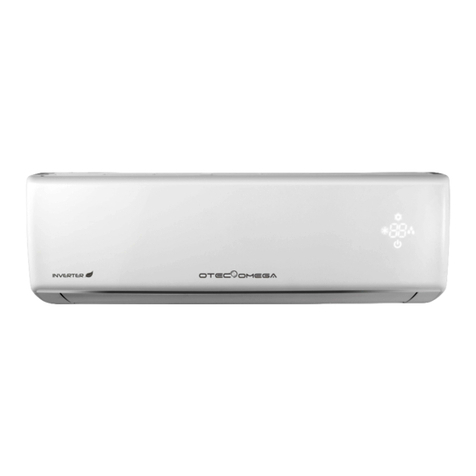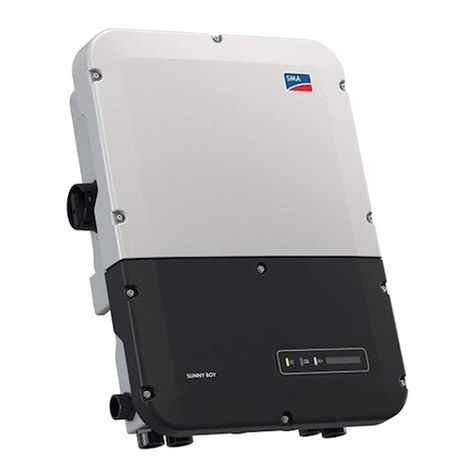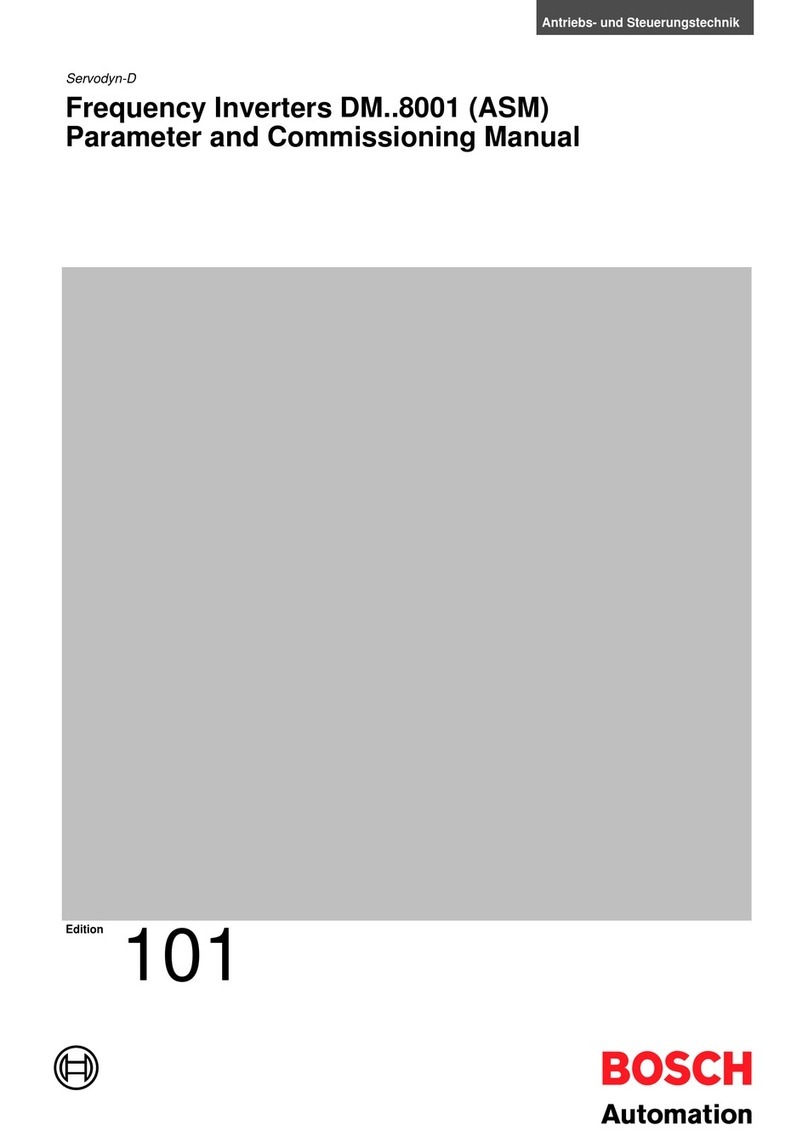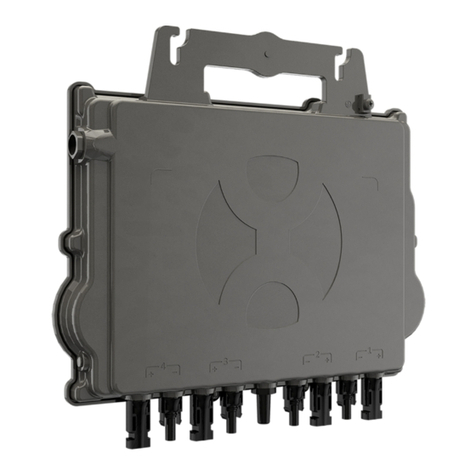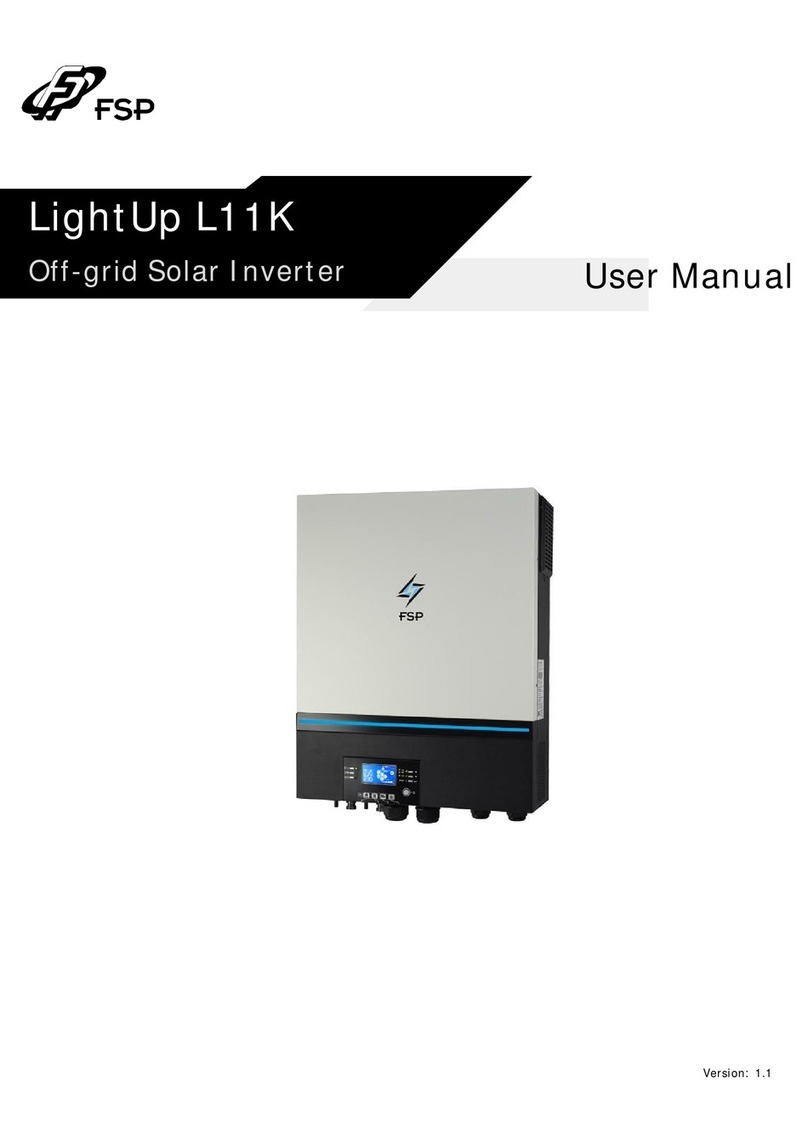Transtecno TT100 series User manual

TT100
·A·
CONTENTS
I. Product ………………………………………………………………..
1.1 Product model naming rule….………………………………
1.2 Optional function naming rule………………………………
1.3 Nameplate……..……………………………………………
1.4 Appearance…………….……………………………………
1.5 Technical Specifications ……………………………………
1.6 Designed Standards for Implementation……………………
1.7 Safe Instructions………………………………………………
1.8 Precautions……………………………………………………
1.9 Examination and Maintenance…………………………..……
II. Keypad panel……………………………………………………..…
2.1 Panel Illustrations……………………………………………
2.2 Panel Structure………………………………………………
2.3 Panel Operating ……………………………………………
2.4 Parameters Setting …………………………………………
2.5 Function Codes Switchover In/Between Code-Groups…..…
2.6 Panel Display ………………………………………………
III. Installation & Connection ………………………………………………
3.1 Installation……………………………………………………
3.2 Connection ……………………………………………………
3.3 Function of Control Terminals……………………………………
3.4 Wiring Recommended…………………………………………
3.5 Lead Section Area of Protect Conductor(grounding wire) ……
3.6 Overall Connection………………………………………………
IV. Operation and Simple Running ………………………………………
V. Function Parameters ……………………………………………………
5.1 Basic Parameters………………………………………………
5.2 Operation Control ……………………………………………..
1
1
1
2
2
4
5
5
6
7
8
8
9
9
10
10
11
12
12
12
14
17
17
18
19
26
26
34

TT100
·B·
5.3 Multifunctional Input and Output Terminals……………………
5.4 Analog Input and Output………………………………….…
5.5 Pusle input and output………………………………….……
5.6 Multi-stage Speed Control…………………….………………
5.7 Auxiliary Functions………………………………..…….……
5.8 Malfunction and Protection……………………………………
5.9 Parameters of the motor………………………………………
5.10 Communication parameters……………………………………
5.11 PID parameters…………………………………………….
Appendix 1 Trouble Shooting…………………………………..…….
Appendix 2 Products and Structure List…………………..…………..
Appendix 3 Selection of Braking Resistance ………………………….….
Appendix 4 Communication Manual………………………………….
Appendix 5 Zoom Table of Function Code ……………………….………
41
45
50
52
54
56
58
58
59
60
61
65
66
75

TT100
·1·
I. Product
This manual offers a brief introduction of the installation connection for TT100 series
inverters, parameters setting and operations, and should therefore be properly kept. Please
contact manufacturer or dealer in case of any malfunction during application.
1.1 Product model naming rule
TT100 –0007 S2
1.2 Optional function naming rule
D F1 Y K B R
Mark
0002
0004
0007
……
Motor power(kw)
0.2
0.4
0.75
……
Mark
Built-in EMIfilter
None
None
R
Including built-in EMI filter
Mark
Built-in braking unit
None
None
B
Including built-in braking unit
Mark
Operation panel with potentiometer
None
Localoperationpanelwithoutpotentiometer
K
Localoperationpanelwithpotentiometer
Mark
Operation panel type
None
Operation panel is not removable.
Y
Operation panel is removable, to be controlled remotely.
Mark
Scene bus type
None
No communication function
F1
With MODBUS communication function
Mark
Structure code
None
Hanging type
D
Cabinet type
Relation
Input power type:
S2 means single-phase 230VAC
T3 means three-phase 400VAC
Motor power
Product series

TT100
·2·
1.3 Nameplate
Taking for instance the TT100 series
0.75KW inverter with 1-phase input, its
nameplate is illustrated as Fig 1-1.
1Ph: single-phase input; 230V, 50/60Hz:
input voltage range and rated frequency.
3Ph: 3-phase output; 4.5A, 0.75KW:
rated output current and power;
0.50~650.0Hz: output frequency range.
1.4 Appearance
The external structure of TT100 series inverter is classified into plastic and metal housings.
And wall hanging type is adopted. Good poly-carbon materials are adopted through
die-stamping for plastic housing with nice form, good strength and toughness.
Taking TT100-0007S2 for instance, the external appearance and structure are shown as in
below Fig.
Vent Hole
Control Terminal
Keypad Controller
Power Terminal
Mounting Hole
Heatsink
Fig 1-1 Nameplate
MODEL
TT100-0007S2
Function
Symbol
F1KBR
INPUT
AC 1PH 230V 50/60Hz
OUTPUT
3PH 0.75KW 4.5A 0~230V
0.50~650.0Hz
条形码

TT100
·3·
1.5 Technical Specifications
Table1-1 Technical Specifications for TT100 Series Inverters
Items
Contents
Input
Rated Voltage Range
3-phase 400V±15%; single-phase 230V±15%
Rated Frequency
50/60Hz
Output
Rated Voltage Range
3-phase 0~400V;3-phase 0~230V
Frequency Range
0.50~650.0Hz
Control
Mode
Carrier Frequency
2000~10000Hz; Fixed carrier-wave and random carrier-wave
can be selected byF159.
Input Frequency Resolution
Digitalsetting:0.01Hz,analogsetting:max frequency
0.1%
Control Mode
VVVF control
Overload Capacity
150% rated current, 60 seconds.
Torque Elevating
Auto torque promotion, Manual Torque Promotion
0.1%~30.0% (VVVF)
V/F Curve
3 kinds of modes: beeline type, square type and
under-defined V/F curve.
DC Braking
DCbraking frequency: 1.0~5.0 Hz,brakingtime:0.0~10.0s
Jogging Control
Jogging frequency range: min frequency~ max frequency,
jogging acceleration/deceleration time: 0.1~3000.0s
Auto Circulating Running and
multi-stage speed running
Auto circulating running or terminals control can realize
15-stage speed running.
Built-in PID adjusting
Easy to realize a system for process closed-loop control
Operation
Function
Frequency Setting
Potentiometer or external analog signal (0~5V, 0~10V,
0~20mA); keypad (terminal)▲/▼ keys, external
control logic and automatic circulation setting.
Start/Stop Control
Terminal control, keypad control or communication control.
Running Command Channels
3 kinds of channels from keypad panel, control terminal and
series communication port.
Frequency Source
Frequency sources: given digit, given analog voltage, given
analog current and given series communication port.
Accessorial frequency Source
Flexible implementation of 5 kinds of accessorial frequency
fine adjustments and frequency compound.
Optional
Built-in EMI filter, built-in braking unit, Modbus communication, telecontrol panel
Protection
Function
Input out-phase, Output out-phase, input under-voltage, DC over-voltage, over-current,
over-load, current stall, over-heat, external disturbance
Display
LED nixie tube showing present output frequency, present rotate-speed (rpm), present output
current, present output voltage, present linear-velocity, types of faults, and parameters for the
system and operation; LED indicators showing the current working status of inverter.
Environment
Conditions
Equipment Location
In an indoor location, Prevent exposure from direct
sunlight, Free from dust, tangy caustic gases, flammable
gases, steam or the salt-contented, etc.
Environment Temperature
-10℃~+50℃
Environment Humidity
Below 90% (no water-bead coagulation)
Vibration Strength
Below 0.5g (acceleration)
Height above sea level
1000m or below

TT100
·4·
Protection
level
IP20
Applicable
Motor
0.2~15KW
1.6 Designed Standards for Implementation
IEC/EN 61800-5-1: 2003 Adjustable speed electrical power drive systems
safety requirements.
IEC/EN 61800-3: 2004 Adjustable speed electrical power drive systems-Part
3: EMC product standard including specific test methods.
1.7 Safe instructions
Please check the model in the nameplate of the inverter and the rated value of
the inverter. Please do not use the damaged inverter in transit.
Installation and application environment should be free of rain, drips, steam,
dust and oily dirt; without corrosive or flammable gases or liquids, metal
particles or metal powder. Environment temperature within the scope of -10℃~
+50℃.
Please install inverter away from combustibles.
Do not drop anything into the inverter.
The reliability of inverters relies heavily on the temperature. The around
temperature increases by 10℃, inverter life will be halved. Because of the wrong
installation or fixing, the temperature of inverter will increase and inverter will
be damaged.
If inverter is installed in a control cabinet, smooth ventilation should be ensured
and inverter should be installed vertically. If there are several inverters in one
cabinet, in order to ensure ventilation, please install inverters side by side. If it is
necessary to install several inverters up and down, please add heat-insulation
plate.

TT100
·5·
1.8 Precautions
1.8.1 Instructions for use
Never touch the internal elements within 15 minutes after power off. Wait till it
is completely discharged.
Input terminals R, S and T are connected to power supply of 400V while output
terminals U, V and W are connected to motor.
Proper grounding should be ensured with grounding resistance not exceeding
4Ω; separate grounding is required for motor and inverter. Grounding with
series connection is forbidden.
Load switch is forbidden at output while inverter is in operation.
AC reactor or/and DC reactor is recommended when your inverter is above 37KW.
There should be separate wiring between control loop and power loop to avoid
any possible interference.
Signal line should not be too long to avoid any increase with common mode
interference.
It shall comply with the requirements for surrounding environment as stipulated
in Table 1-1 “Technical Specifications for TT100 Series Inverter”.
1.8.2 Special Warning!!
Never touch high-voltage terminals inside the inverter to avoid any electric shock.
Before inverter is powered on, please be sure that input voltage is correct.
Please do not connect input power supplyonto U,V,Wor terminals.
Please do not install inverter directly under sunshine, do not block up the cooling hole.

TT100
·6·
All safety covers should be well fixed before inverter is power connected, to
avoid any electric shock.
Only professional personnel are allowed for any maintenance, checking or
replacement of parts.
No live-line work is allowed.
1.9 Maintenance
1.9.1 Periodic Checking
Cooling fan and wind channel should be cleaned regularly to check whether it is
normal; remove the dust accumulated in the inverter on a regular basis.
Check inverter‟s input and output wiring and wiring terminals regularly and
check if wirings are ageing.
Check whether screws on each terminals are fastened.
Check whether inverter is corrosive.
1.9.2 Replacement of wearing parts
The wearing parts include cooling fan and electrolytic capacitors.
The life of the fan usually is 2~3 years. Users should change the cooling fan
according to all running time of inverter. Cooling fan could be damaged
because bearing is damaged and fan blades are aging. Users could check fan
blades for cracks or check the abnormal vibration noise when starting. Users
could change fan according to abnormal phenomena.
The useful life of electrolytic capacitors is 4~5 years. Users should change the
electrolytic capacitors according to all running time of inverter. Capacitors
could be damaged because the power supply is unstable, the environment
temperature is high, frequent over-load occurs and electrolyte is ageing. By
checking whether there is leakage of liquid, or the safety valve bulges out, or
the static electricity and insulated resistor is ok, users could change the
capacitor according to these phenomena.
1.9.3 Storage
Please put the inverter in the packing case of manufacture.
If inverter is stored for long time, please charge the inverter within half a year
to prevent the electrolytic capacitors damaged. The charging time should be
longer than 5 hours.
1.9.4 Daily Maintenance
Environment temperature, humidity, dust and vibration would decrease the life of
inverter. So daily maintenance is necessary to inverter.
Daily inspecting:
Inspecting for noise of motor when it is working.
Inspecting for abnormal vibration of motor when it is working.
Inspecting for the installing environment of inverter.
Inspecting for the fan and inverter temperature.
Daily cleaning:
Keep the inverter clean. Clean surface dust of inverter to prevent dust, metal
powder, oily dirt and water from dropping into the inverter.Inspecting for the fan
and inverter temperature.
Daily cleaning:
Keep the inverter clean. Clean surface dust of inverter to prevent dust, metal
powder, oily dirt and water from dropping into the inverter.

TT100
·7·
II. Keypad panel
Keypad panel and monitor screen are both fixed on keypad controller. Two kinds of controllers (with and
without potentiometer) are available for TT100 series inverters. Refer to note for Fig2-1.
2.1 Panel Illustration
The panel covers three sections: data display section, status indicating section and keypad operating section,
as shown in Fig. 2-1.
Instructions for operation panel:
Operation panels of below 15KW can not be pulled out. Please select AA or A6 control panel to realize
remote control, which is connected by 4 core telephone wire.
.
Operation panel
RUN FWD DGT FRQ
Min Max
Fun
Set
▲
▼
Run
stop
reset
4LEDsindicateworkingstatus.RUNis lightingwhilerunning.FWDislighting
whenworkingforwardandFRQislightingwhenshowingfrequency.
4个发光二极管指示工作状态。运行时 RUN亮,正转时 FWD亮,功能
码区间内切换 DGT 亮,FRQ亮表示显示频率。
LED shows running frequency, flashing target frequency, function code,
parameter value or fault code.
Press “Fun”for function code, and “set”for original parameters.▲
and▼keys can be used to select function codes and parameters.
Press “set”again to confirm. In the mode of keypad control, ▲and
▼keys can also be used for dynamic speed control. “Run”and
“Stop/Reset”keys control start and stop. Press “Stop/Reset”key to
reset inverter in fault status.
Potentiometer can be used for manual speed control in mode of
analog signals control. External potentiometer or external analog
signal can also be used.
Fun
Set
▲
▼
Run
Stop
reset
RUN FWD DGT FRQ
LED shows running frequency, flashing target frequency, function code,
parameter value or fault code.
4LEDsindicateworkingstatus.RUNislightingwhilerunning.FWDislighting
whenworkingforwardandFRQislightingwhenshowingfrequency.
Press “Fun”for function code, and “set”for original parameters.▲
and▼keys can be used to select function codes and parameters.
Press “set”again to confirm. In the mode of keypad control, ▲and
▼keys can also be used for dynamic speed control. “Run”and
“Stop/Reset”keys control start and stop. Press “Stop/Reset”key to
reset inverter in fault status.
Operation panel
Fig.2-1 Operation Panels in Two Kinds

TT100
·8·
2.2 Panel structure
1. structure diagram
2. Structure size (Unit: mm)
Code
A
B
C
D
H
Opening size
AA
76
52
72
48
24
73*49
A6
124
74
120
70
26
121*71
2.3 Panel Operating
All keys on the panel are available for user. Refer to Table 2-1 for their functions.
Table 2-1 Uses of Keys
Keys
按键
Names
Remarks
Fun
To call function code and switch over display mode.
Set
To call and save data.
Up
To increase data (speed control or setting parameters)
Down
To decrease data (speed control or setting parameters)
Run
To start inverter;
Stop or reset
To stop inverter; to reset in fault status; to change function codes in a code
group or between two code groups.
Fun
Set
Run
Stop/reset
▲
▼

TT100
·9·
2.4 Parameters Setting
This inverter has numerous function parameters, which the user can modify to effect different modes of
operation control. User needs to realize that if user sets password valid (F107=1), user‟s password must be
entered first if parameters are to be set after power off or protection is effected, i.e., to call F100 as per the
mode in Table 2-2 and enter the correct code. User‟s password is invalid before delivery, and user could set
corresponding parameters without entering password.
Table 2-2 Steps for Parameters Setting
Steps
Keys
Operation
Display
1
Press “Fun” key to display function code
2
Press “Up” or “Down” to select requiredfunctioncode
3
To read data set in the function code
4
To modify data
5
To show corresponding target frequency by flashing
after saving the set data
To display the current function code
The above-mentioned step should be operated when inverter is in stop status.
2.5 Function Codes Switchover in/between Code-Groups
It has more than 300 parameters (function codes) available to user, divided into 10 sections as indicated in Table 2-3.
Table 2-3 Function Code Partition
Group Name
Function
Code Range
Group
No.
Group Name
Function
Code Range
Group
No.
Basic Parameters
F100~F160
1
Subsidiary function
F600~F630
6
Run Control Mode
F200~F230
2
Timing control and
protection function
F700~F740
7
Multi-functional
input/output terminal
F300~F330
3
Parameters of the motor
F800~F830
8
Analogsignals of
input/output
F400~F439
4
Communication
function
F900~F930
9
Pulse of input/output
F440~F460
4
PID parameter setting
FA00~FA30
10
Multi-stage speed
parameters
F500~F580
5
As parameters setting costs time due to numerous function codes, such function is specially designed as
“Function Code Switchover in a Code Group or between Two Code-Groups” so that parameters setting
become convenient and simple.
Press “Fun” key so that the keypad controller will display function code. If press “▲” or “▼” key then,
Fun
▲
▼
or
Set
Set
Fun
▲
▼
or
F
1
1
4
F
1
1
4

TT100
·10·
function code will circularly keep increasing or decreasing by degrees within the group; if press the
“stop/reset” key again, function code will change circularly between two code groups when operating the
“▲” or “▼” key.
e.g. when function code shows F111 and DGT indicatoris on, press “▲”/ “▼” key, function code will keep
increasing or decreasing by degrees within F100~F160; press “stop/reset” key again, DGT indicator will be
off. When pressing “▲”/ “▼” key, function codes will change circularly among the 10 code-groups, like
F211, F311…FA11, F111…, Refer to Fig 2-2 (The sparkling “ is indicated the corresponding target
frequency values).
2.6 Panel Display
Table 2-4 Items and Remarks Displayed on the Panel
Items
Remarks
HF-0
This Item will be displayed when you press “Fun” in stopping status, which indicates jogging
operation is valid. But HF-0 will bedisplayedonlyafter you changethe valueof F132.
-HF-
It stands for resetting process and will display target frequency after reset.
OC,OC1,OE,
OL1,OL2,OH,
LU,PF0,PF1
Fault code, indicating “hardware over-current”, “software over-current”,
“over-voltage”, “inverter over-load”, “motor over-load”“over-heat”, “under-voltage
for input”, “out-phase for input” ,” and “out-phase for output”respectively.
ESP
During two-line/three line running mode, “stop/reset”key is pressed or external emergency stop
terminalisclosed,ESPwillbedisplayed.
F152
Function code (parameter code).
10.00
Indicating inverter‟s current running frequency (or rotatespeed)andparametersettingvalues,etc.
Sparklinginstoppingstatustodisplaytarget frequency.
0.
Holdingtimewhenchangingtherunningdirection. When “Stop” or “Free Stop” command is executed,
theholdingtimecanbecanceled
A100、U100
Output current (100A) and output voltage (100V). Keep one digit of decimal when current is below
100A.
Enter correct user‟s
password (currently
showing )
Fun
Display
Display
DGT
Stop/Reset
Display
DGT
▲
Display
▲
Display
▲
Display
DGT Off
DGT On
Fig2-2 SwtichoverinaCodeGrouporbetweenDifferentCode-Groups

TT100
·11·
III. Installation & Connection
3.1 Installation
Inverter should be installed vertically, as shown in Fig 3-1. Sufficient ventilation space should be ensured in
its surrounding. Clearance dimensions (recommended) are available from Table 3-1 for installing the
inverter.
Table 3-1 Clearance Dimensions
Inverter Model
Clearance Dimensions
Hanging (≤ 15 kw)
A≥150mm
B≥50mm
3.2 Connection
In case of 3-phase input, connect R/L1,
S/L2 and T/L3 terminals (L1/R and
L2/S terminals for single-phase) with
power source from network and
/PE/E to earthing, U, V and W terminals to motor.
Motor shall have to be ground connected. Orelse electrified motor causes interference.
For inverter power lower than 15kw, braking cell is also built-in. If the load inertia is moderate,
it is Ok to only connect braking resistance.
Power terminals sketch of inverter with single-phase 230V 0.2~0.75KW.
L1
L2
P
B
U
V
W
Power terminals sketch of inverter with single-phase 230V 1.5~2.2KW and three-phase
400V 0.75KW~15KW.
L1/R
L2/S
L3/T
P
-
B
U
V
W
Note: power terminals L1/R, L2/S of single-phase 230V 1.5KW and 2.2KW are connected
to 230V of power grid; L3/T is not connected.
The inverters below 11kw have no the terminal “-”.
Grounding
Input ~400V
For braking resistor
Output
Grounding
Input ~230V
For braking resistor
Output
A
B B
A
Inverter
C
D D
Inverter
Trench
Hanging
Cabinet
Fig 3-1 Installation Sketch

TT100
·12·
(The figure is only sketch, terminals order of practical products may be different from the above-mentioned
figure.) Introduction of terminals of power loop
Terminals
Terminal
Marking
Terminal Function Description
Power Input
Terminal
R/L1, S/L2,
T/L3
Input terminals of three-phase 400V AC voltage (R/L1 and S/L2
terminals for single-phase)
Output Terminal
U, V, W
Inverter power output terminal, connected to motor.
Grounding
Terminal
/PE/E
Inverter grounding terminal.
Rest Terminal
P, B
External braking resistor (Note: no Terminals P or B for inverter
without built-in braking unit).
P+、-(N)
DC bus-line output
P、-(N)
Externally connected to braking unit
P connected to input terminal “P” or “DC+”of braking unit, -(N)
connected to input terminal of braking unit “N” or “DC-”.
P, P+
Externally connected to DC reactor
Wiring for control loop as follows:
A+
B-
TA
TB
TC
DO1
DO2
24V
CM
OP1
OP2
OP3
OP4
OP5
OP6
OP7
OP8
10V
AI1
AI2
GND
AO1
AO2
Note: 15KW inverters and below 15KW have no A+、B- , DO2 and OP7, OP8 control terminal.
3.3 Functions of control terminals
The key to operate the inverter is to operate the control terminals correctly and flexibly. Certainly, the control
terminals are not operated separately, and they should match corresponding settings of parameters. This
chapter describes basic functions of the control terminals. The users may operate the control terminals by
combining relevant contents hereafter about “Defined Functions of the Terminals”.
Table 4-3 Functions of Control Terminals
Terminal
Type
Description
Function

TT100
·13·
DO1
Output
signal
Multifunctional
output terminal 1
When the token function is valid, the value
between this terminal and CM is 0V; when the
inverter is stopped, the value is 24V.
The functions of output
terminals shall be defined
per manufacturer‟s value.
Their initial state may be
changed through
changing function codes.
DO2Note
Multifunctional
output terminal 2
When the token function is valid, the value
between this terminal and CM is 0V; when the
inverter is stopped, the value is 24V.
TA
Relay contact
TC is a common point, TB-TC are normally
closed contacts, TA-TC are normallyopen
contacts. The contact capacity of 15kw and below
15kw inverter is 10A/125VAC、5A/250VAC、
5A/30VDC, contact capacity of bove 15kw is
12A/125VAC、7A/250VAC、7A/30VDC.
TB
TC
AO1
Running
frequency
It is connected with frequency meter or speedometer externally, and its
minus pole is connected with GND. See F423~F426 for details,.
AO2
Current display
It is connected with ammeter externally, and its minus pole is connected
with GND. See F427~F430 for details
10V
Analog
power
supply
Self contained
power supply
Internal 10V self-contained power supply of the inverter provides power
to the inverter. When used externally, it can only be used as the power
supply for voltage control signal, with current restricted below 20mA.
AI1
Input
Signal
Voltage analog
input port
When analog speed control is adopted, the voltage signal is input through
this terminal. The range of voltage input is 0~10V, grounding: GND.
When potentiometer speed control is adopted, this terminal is connected
with center tap, earth wire to be connected to GND.
AI2
Voltage / Current
analog input port
When analog speed control is adopted, the voltage or current signal is
input through this terminal. The range of voltage input is 0~5V or 0~10V
and the current input is 0~20mA, input resistor is 500Ω, grounding:
GND. If the input is 4~20mA, it can be realized through adjusting
parameter F406=2. The voltage or current signal can be chosen by coding
switch. See table 4-2 and 4-3 for details, the current channel (0-20mA) is
chosen before delivery.
GND
Self-contained
Power
supplyGround
Ground terminal of external control signal (voltage control signal or
current source control signal) is also the ground of 10V power supply of
this inverter.
24V
Power
supply
Control power
supply
Power: 24±1.5V, grounding: CM; current is restricted below 50mA for
external use.
OP1
Digital
input
control
terminal
Jogging terminal
When this terminal is in the valid state, the
inverter will have jogging running. The
jogging function of this terminal is valid
under both at stopped and running status. This
terminal can also be used as high-speed pulse
input port. The max frequency is 50K.
The functions of input
terminals shall be defined
per manufacturer‟s value.
Other functions can also
be defined by changing
function codes.
OP2
External
Emergency Stop
When this terminal is in the valid state, “ESP”
malfunction signal will be displayed.
OP3
“FWD”Terminal
When this terminal is in the valid state,
inverter will run forward.
OP4
“REV”Terminal
When this terminal is in the valid state,
inverter will run reversely.
OP5
Reset terminal
Make this terminal valid under fault status to
reset the inverter.
OP6
Free-stop
Make this terminal valid during running can

TT100
·14·
realize free stop.
OP7
Running terminal
When this terminal is in the valid state,
inverter will run by the acceleration time.
OP8
Stop terminal
Make this terminal valid during running can
realize stop by the deceleration time.
CM
Common
port
Groundingof
controlpower
supply
The grounding of 24V power supply and other control signals.
A+note
485
communic
ation
terminals
Positivepolarityof
differentialsignal
Standard: TIA/EIA-485(RS-485)
Communication protocol: Modbus
Communication rate: 1200/2400/4800/9600/19200/38400/57600bps
B-note
Negativepolarityof
Differentialsignal
Note : 15KW inverters and below 15KW have noA+, B- , DO2 and OP7, OP8 control terminal.
Wiring for digital input terminals:
Generally, shield cable is adopted and wiring distance should be as short as possible. When active
signal is adopted, it is necessary to take filter measures to prevent power supply interference. Mode of
contact control is recommended.
Digital input terminals are only connected by source electrode (NPN mode) or by drain electrode (PNP
mode). If NPN mode is adopted, please turn the toggle switch to the end of “NPN”.
Wiring for control terminals as follows:
1. Wiring for positive source electrode (NPN mode).
2. Wiring for active source electrode (NPN
mode)

TT100
·15·
NPN
PNP
Fig3-2 ToggleSwitch J7
If digital input control terminals are connected by drain electrode, please turn the toggle switch to the
end of “PNP”. Wiring for control terminals as follows:
3. Wiring for positive drain electrode (PNP mode)
4. Wiring for active drain electrode (PNP mode)
Wiring by source electrode is a mode most
in use at present. Wiring for control terminal is connected by source electrode before delivery, user
should choose wiring mode according to requirement.
Instructions of choosing NPN mode or PNPmode:
1. There is a toggle switch J7 near to control terminals. Please refer to
Fig 3-2.
2. When turning J7 to “NPN”, OP terminal is connected to CM.
When turning J7 to “PNP”, OP terminal is connected to 24V.

TT100
·16·
3. J7 is on the back of control PCB of single-phase 0.2KW-0.75KW.
3.4 Wiring Recommended
Inverter Model
LeadSectionArea(mm2)
TT100-0002S2
1.0
TT100-0004S2
1.5
TT100-0007S2
2.5
TT100-0015S2
2.5
TT100-0022S2
4.0
TT100-0007T3
1.5
TT100-0015T3
2.5
TT100-0022T3
2.5
TT100-0037T3
2.5
TT100-0040T3
2.5
TT100-0055T3
4.0
TT100-0075T3
4.0
TT100-0110T3
6.0
TT100-0150T3
10
3.5 Lead section area of protect conductor (grounding wire)
Lead section area S of U,V,W (mm2)
Minimum lead section area S of /PE/E (mm2)
S
16
16<S
35
35<S
S
16
S/2
3.6 Overall Connection and “Three- Line” Connection
*Refer to next figure for overall connection sketch for TT100 series inverters. Wiringmodeis available for various
terminalswhereasnoteveryterminalneedsconnection whenapplied.

TT100
·17·
Note:
1.Pleaseonlyconnectpowerterminals L1/RandL2/Swithpowergridforsingle-phaseinverters.
2. Remote-control panels and 485 communication port should be connected with 4 core telephone wire. They must not
beused atthesametime.
3. 485 communication port has built-in standard MODBUS communication protocol. Communication port is on the left
sideofinverter.Thesequence fromtoptodownis5Vpower,B-terminal,A+terminalandGNDterminal.
4. Inverter above 15kw has 8 multifunctional input terminals OP1~OP8, 15kw inverter and below 15kw has 6
multifunctionalinput terminals OP1~OP6.
5. The contact capacity of 15kw and below 15kw inverter is 10A/125VAC、5A/250VAC、5A/30VDC.
IV. Operation and Simple Running

TT100
·18·
This chapter defines and interprets the terms and nouns describing the control, running and status of the
inverter. Please read it carefully. It will be helpful to your correct operation.
4.1 Control mode
Control mode of TT100 inverter is V/F control.
4.2 Mode of torque compensation
Linear compensation (F137=0); Square compensation (F137=1); User-defined multipoint compensation
(F137=2); Auto torque compensation (F137=3)
4.3 Mode of frequency setting
Please refer to F203~F207 for the method for setting the running frequency of the TT100 inverter.
4.4 Mode of controlling for running command
The channel for inverter to receive control commands (including start, stop and jogging, etc) contains three
modes: 1. Keypad (keypad panel) control; 2. External terminal control; 3. Modbus control.
The modes of control command can be selected through the function codes F200 and F201.
4.5 Operating status of inverter
When the inverter is powered on, it may have four kinds of operating status: stopped status, programming
status, running status, and fault alarm status. They are described in the following:
4.5.1 Stopped status
If re-energize the inverter (if “self-startup after being powered on”is not set) or decelerate the inverter to
stop, the inverter is at the stopping status until receiving control command. At this moment, the running
status indicator on the keypad goes off, and the display shows the display status before power down.
4.5.2 Programming status
Through keypad panel, the inverter can be switched to the status that can read or change the function
code parameters. Such a status is the programming status.
There are numbers of function parameters in the inverter. By changing these parameters, the user can
realize different control modes.
4.5.3 Running status
The inverter at the stopped status or fault-free status will enter running status after having received
operation command.
The running indicator on keypad panel lights up under normal running status.
4.5.4 Fault alarm status
The status under which the inverter has a fault and the fault code is displayed.
Fault codes mainly include: OC, OE, OL1, OL2, OH, LU, PF1, representing “over current”, “over
voltage”, “inverter overload”, “motor overload”, “overheat”, “input undervoltage”, “input out-phase”, and
respectively.
For trouble shooting, please refer to Appendix I to this manual, “Trouble Shooting”.
4.6 Keypad panel and operation method
Keypad panel (keypad) is a standard part for configuration of TT100 inverter. Through keypad panel, the
user may carry out parameter setting, status monitoring and operation control over the inverter. Both keypad
panel and display screen are arranged on the keypad controller, which mainly consists of three sections: data
display section, status indicating section, and keypad operating section. There are two types of keypad
controller (with potentiometer or without potentiometer) for inverter. For details, please refer to Chapter II of
this manual, “Keypad panel”.
It is necessary to know the functions and how to use the keypad panel. Please read this manual carefully
Table of contents
Popular Inverter manuals by other brands
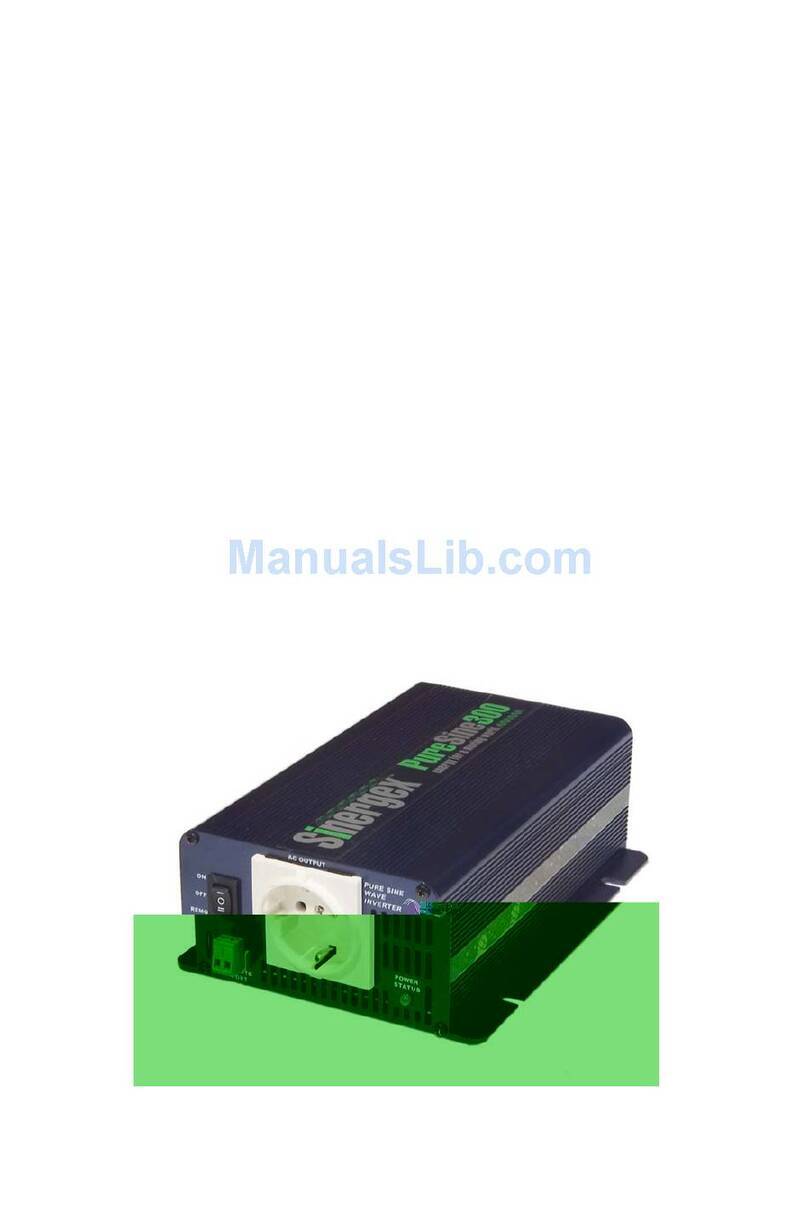
Go Power
Go Power PureSine 150 user manual
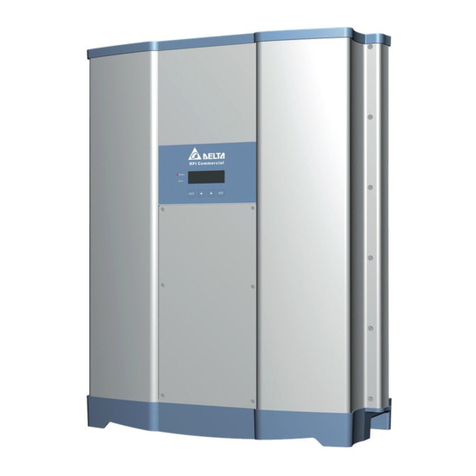
Delta
Delta RPI M50A Installation and operation manual
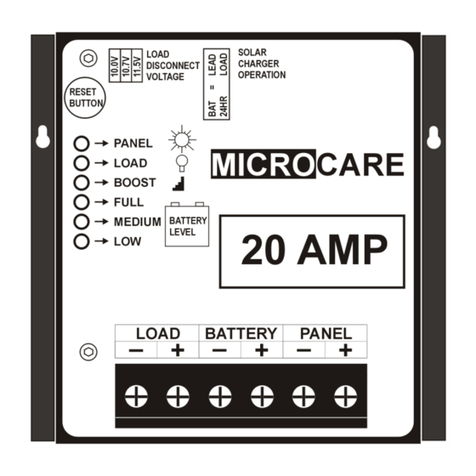
Microcare
Microcare 10 Amp user manual
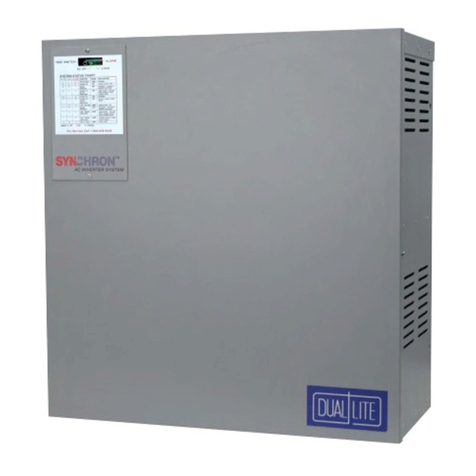
DualLite
DualLite SYNCHRON Installation instructions and user manual
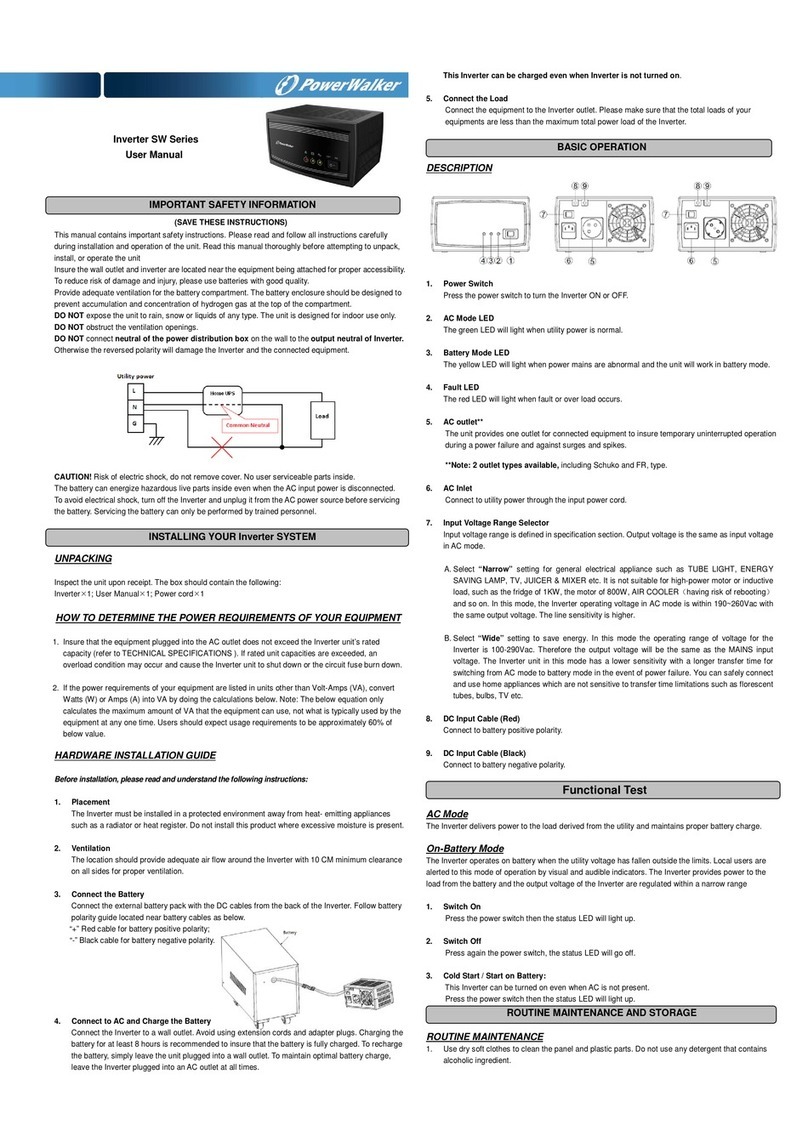
PowerWalker
PowerWalker 650 SW user manual

LIVARNO LUX
LIVARNO LUX 311196 Assembly, operating and safety instructions
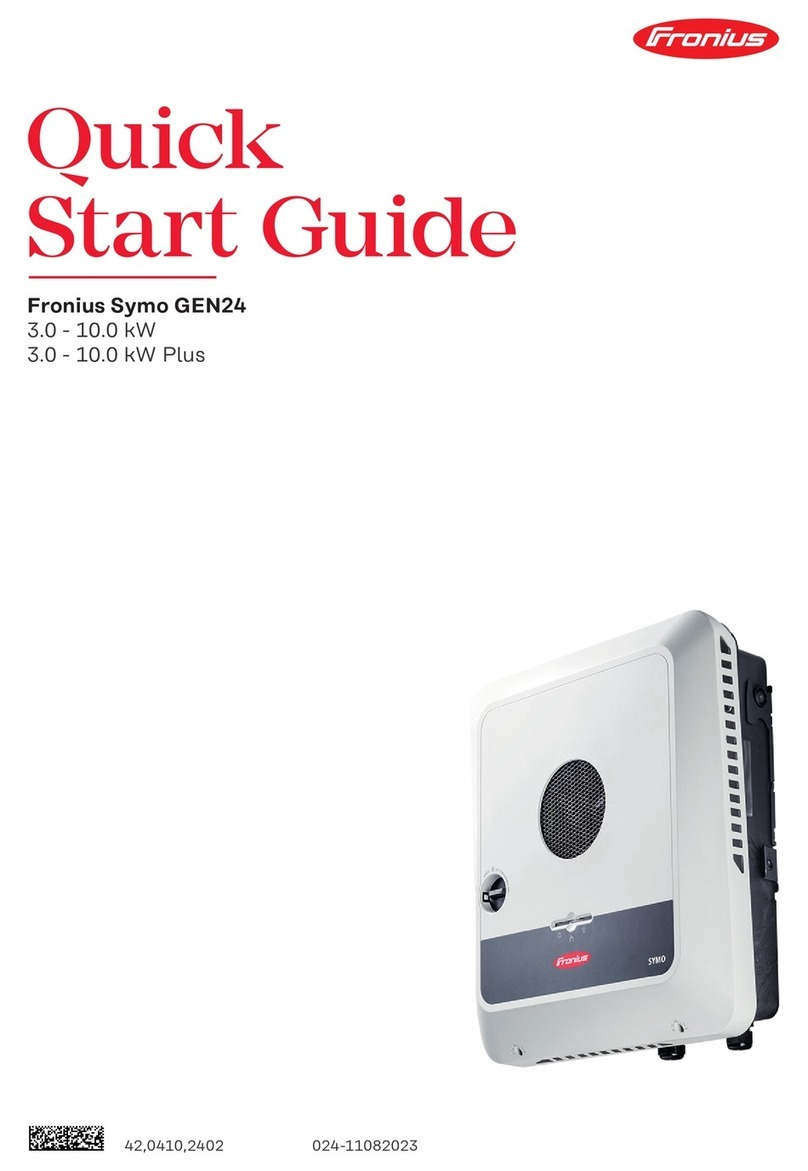
FRONIUS
FRONIUS Symo GEN24 quick start guide
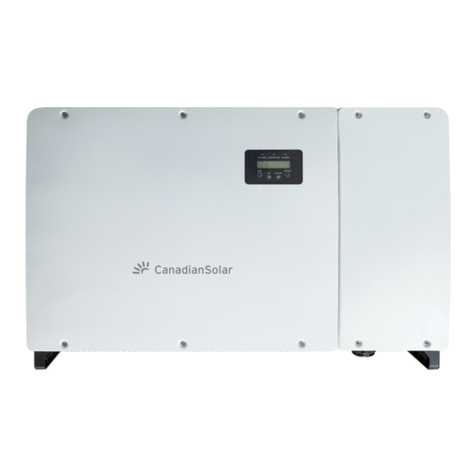
CanadianSolar
CanadianSolar CSI-125KTL-GS-E Installation and operation manual
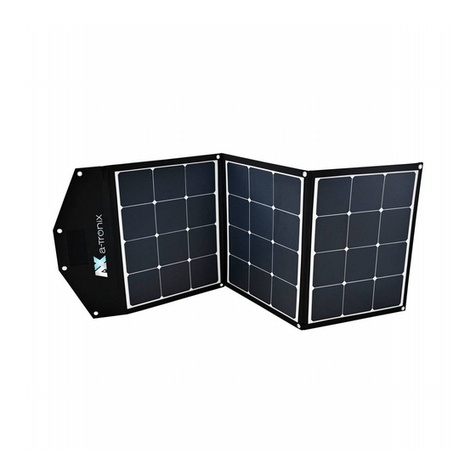
Atronix
Atronix PPS Solar bag user manuel

Qcells
Qcells Q.HOME CORE H4 installation manual
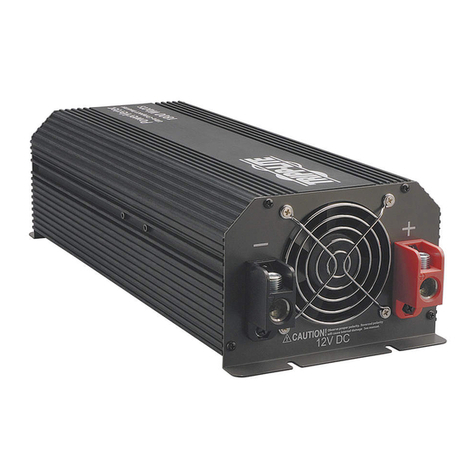
Tripp Lite
Tripp Lite PowerVerter owner's manual
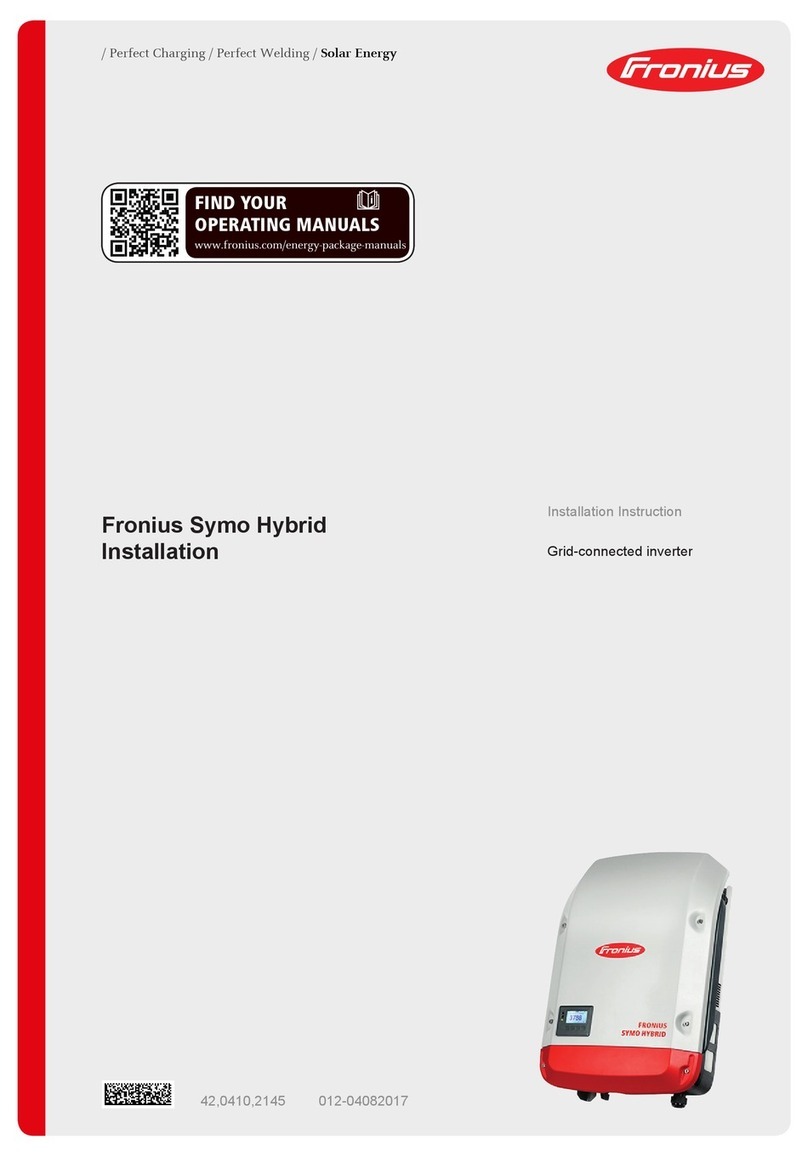
FRONIUS
FRONIUS Symo Hybrid Installation instruction
